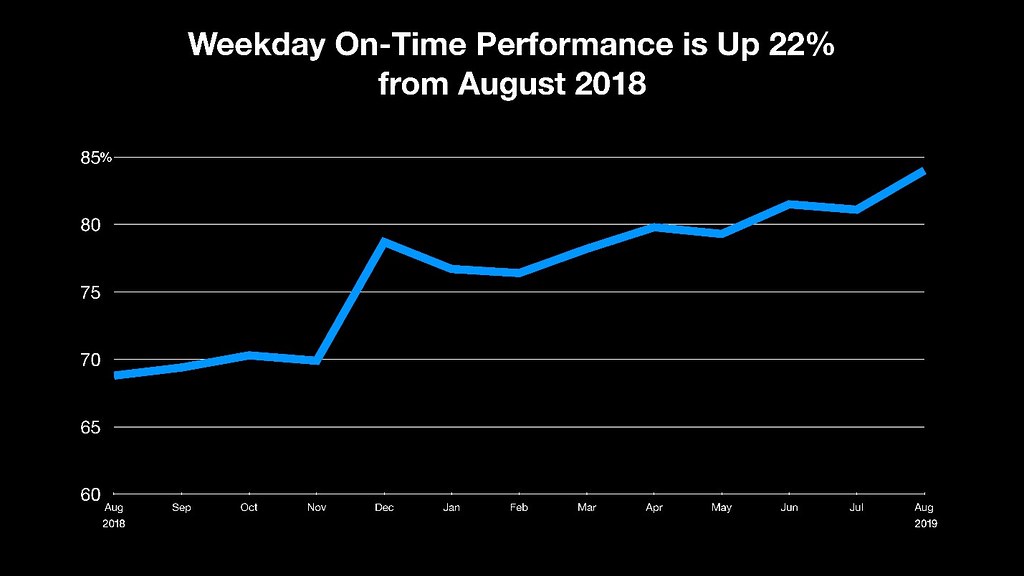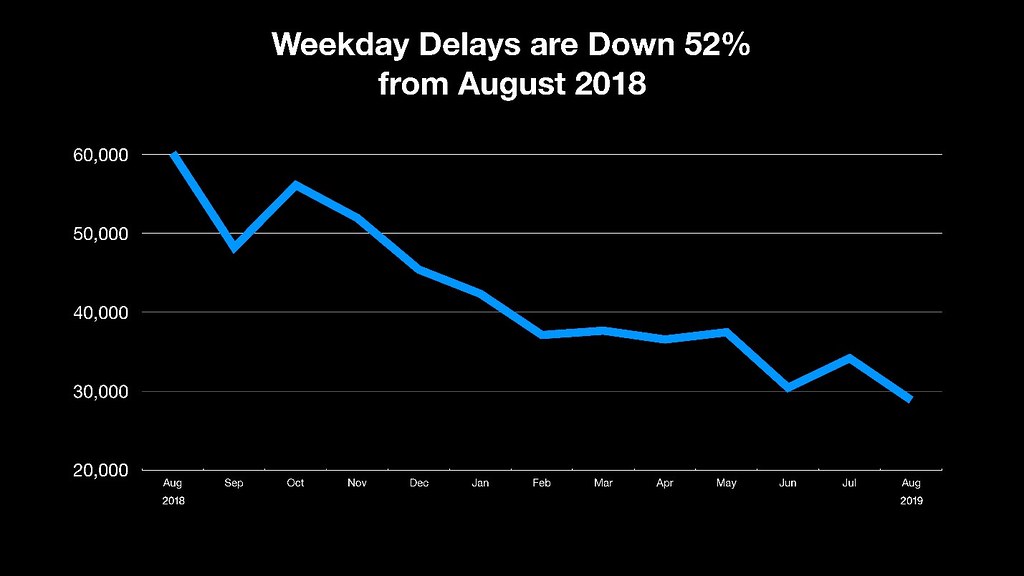 |
|
|
September 12, 2019
|
|
Subway Performance Continues to Improve, Reaching Highest Weekday On-Time Performance Since 2013 and Demonstrating Subway Action Plan is Working |
|
Weekday On-Time Performance in August Reached 84%, Up from 69% Last August and Highest Since April 2013; Number of Weekday Delays Fell 52% Since August 2018, to Less Than 29,000; Major Incidents Fell to a New Low of 38, Down Nearly 40% Since Last August; Hot Car Incidents Down 30%; Improvements Speak to Efficacy of Accelerated Pace of Maintenance and Repair Work Done Through Subway Action Plan, and the Focus on Improving the Precision of Operations Through NYCT’s Save Safe Seconds Campaign; Commendations from Customers Skyrocket 91% The Metropolitan Transportation Authority (MTA) today announced new statistics showing continued and dramatic subway performance improvements that have been achieved since the launch of the Subway Action Plan in 2017. New York City Transit President Andy Byford and Department of Subways Senior Vice President Sally Librera, flanked by frontline employees and other subways officials, unveiled the news this morning at a Fulton Street press conference. On-Time Performance (OTP) numbers reached 84% on weekdays, up from 68.8% in August of last year. OTP measures the percentage of trains that arrive at their terminal location within five minutes of their scheduled arrival time and made all scheduled stops. Meanwhile, Major Incidents, which are defined as incidents that delay 50 or more trains, continued to decline at a rapid clip as well, with just 38 such incidents in August. That figure represents a nearly 40% reduction from the same month last year and marks a new low since New York City Transit began compiling data on the metric in 2015. MTA officials credited the improvements, which will be released in full late next week, to the critical maintenance work done during the Subway Action Plan and to the data-driven processes, full employee engagement, and optimal operations focus set forth in the Fast Forward Plan and implemented in programs like NYCT’s Save Safe Seconds campaign. Subway speeds have been safely increased at 150 locations. “I am immensely proud of my colleagues throughout the Department of Subways and in Operations Planning who have once again produced incredible results,” said Andy Byford, New York City Transit President. “Today’s subway performance numbers provide yet another reminder that thoughtful and strategic decision making that targets the root causes of delays and that focuses on getting the basics right can yield outstanding results. We still have to improve further, but as the data definitively shows, things are markedly better than they were before we launched the Save Safe Seconds initiative, part of our Fast Forward plan, last summer. Our combination of data-driven decision making and critical investment in overdue maintenance through the Subway Action Plan has the entire system in a much better place than it was even a year ago.” “By better tracking performance across a host of categories, we are pinpointing problem areas throughout the system,” said Senior Vice President for Subways Sally Librera. “This has allowed us to more precisely determine how best to deploy our maintenance and repair efforts. Taken in tandem with our work to identify more efficient ways of safely operating trains, we are seeing the sorts of dramatic improvements that can be achieved when the entire subways team is engaged in delivering improved service for our customers. There are too many people to name that deserve immense credit for delivering better service and I’m proud to work with them each day.” August also saw an improvement in the reliability of New York City Transit’s subway car fleet, particularly the air conditioning systems. Overall Mean Distance Between Failure (MDBF) figures increased by nearly 8% compared to last August, while the system’s new technology cars reached a 12-month average MDBF of 208,072 miles. That figure is the system’s highest in over six years for the new technology cars, which currently make up 55% of the fleet. The Car Equipment team committed to improving air conditioning reliability for the comfort of our customers and implemented several management strategies to monitor performance and rapidly address any issues as they were found. The result was a 30% reduction in the number of “hot cars” compared to last year and over 98% of cars found with comfortable temperatures during weekly inspections. ADDITIONAL PERFORMANCE HIGHLIGHTS FROM AUGUST:
MORE INFORMATION ABOUT THE SUBWAY ACTION PLAN The Subway Action Plan launched at the direction of Governor Cuomo in July 2017, and funded by the governor, legislature and city, with the goal of taking extraordinary measures to stabilize and improve the more than 100-year old subway system, has been critical to the recent performance improvements. During the Subway Action Plan, MTA workers and outside contractors have:
    |
|
|
###
|